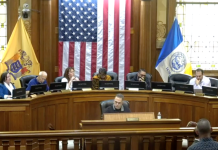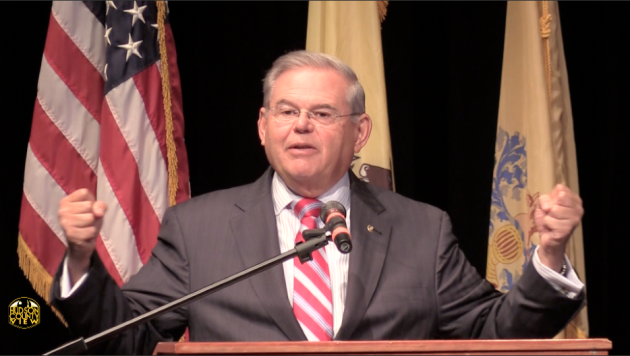With one week to go before the Hoboken City Council votes on whether to move the city’s rail yard redevelopment plan forward, residents learned more from the developer and city officials about the most recent changes to the plan.
Representatives from LCOR, the developer of the project, pointed to renderings of some of the structures that will be built along a stretch of Observer Highway and talked with residents about some of the anticipated benefits.
They include a 1.3 million square foot redevelopment, reduced from 2.3 million square feet, that will offer job opportunities for Hoboken residents, new ratables, increased retail spending, and a minimum of 20 percent of the plan dedicated to affordable housing.
1st Ward Councilman Mike DeFusco and Councilwoman-at-Large Vanessa Falco recently announced the 20 percent affordable housing component to the plan and during yesterday’s public meeting, they both said they would push back against any effort to reduce that amount.
“Any push back on 20 percent affordable housing would mean pushback from myself and the majority of the council. I was really proud to work with Councilwoman Falco to secure that percentage … any large-scale residential project that is going to come to Hoboken needs to include 20 percent,” said DeFusco.
“The original requirement was 10 percent, but we were able to negotiate the deal at 20 percent. We are sending a message that this is the type of development that we’d like to see going forward in Hoboken, the issue of affordability has been long neglected,” added Falco.
Brian Barry, senior vice president of LCOR, said during an interview that the economics of the plan still work with 20 percent affordable housing.
“Any change would obviously, potentially, have an impact on economics. Look, as a development company, we realize the importance of delivering affordable housing in a high-cost environment, so we recognize the importance of that for the various council members, as well as the residents of Hoboken,” said Barry.
The origin of the Hoboken Yard Redevelopment Plan dates back to 2007 when the city declared the area in need of redevelopment and asked the owner, NJ Transit – which owns the land of eight blocks along Observer Highway up from Hoboken Terminal – to prepare a plan to designate a total development square footage.
That plan was rejected by the city before it embarked on its own plan in 2011 by hiring an outside planning consultant.
Since then, the plan has undergone a series of revisions to meet the needs of the different stakeholders, which also includes the PATH because its rail infrastructure is below grade along the redevelopment stretch.
Also involved is the New Jersey Department of Environmental Protection, since the federally funded $230 million Rebuild by Design resist barrier to mitigate flooding from storms on the scale of a Superstorm Sandy will be part of the development.
Barry said it was a delicate balance trying to assuage the concerns and meet the needs of the different stakeholders during many hours of negotiations that still makes the project economically feasible.
“As the designated redeveloper for NJ Transit and the city, we had to find a way to balance the interests of all those stakeholders and move forward a plan that was financially feasible. It’s complicated and it’s time consuming, but by listening and having all of the participants at the table we can generate success in this process.”
During a boisterous public meeting last month, Hoboken residents had their first chance to weigh in on the features of the plan since Mayor Ravi Bhalla took office.
After expressing concerns about parking, traffic, and the environment, the council unexpectedly voted on the first reading of an amended plan earlier this month.
Arguably the most significant change is that a 944,000 square-foot area previously designated as “future potential development†has now been roped off as a “no build zone†to accommodate Rebuild by Design.
He reiterated his position from last month that the time to act is now since all stakeholders are on board, noting that the December 4th vote by the city council could be pivotal.
“I would say any private/public partnership where you have multiple public stakeholders, it requires leadership, and success is contingent upon that. And during the course of my tenure on this project this is, I think, the most cohesive moment in time where we’ve had the leadership from the different entities all rowing in the same direction,” Barry said.
1st Ward Councilman DeFusco took credit for playing a role in last night’s public meeting, which he said was necessary to prevent the city administration from “rushing” a plan through weeks before the November 5 election.
“I think you saw the council stand with the community in raising a red flag that the mayor was trying to push a massive redevelopment project weeks before a pivotal election,” began DeFusco.
“Because the council majority stood firm and stood with the community, we were able to stop a vote until after the election. I’m really proud that even since November 6, the initial vote after the election, we were able to make the plan even better.”
Part of making the “plan even better” was the release and circulation to the public of a traffic impact study.
According to LCOR, the study was prepared by Maser Consulting, which was reviewed by Kimley Horn on behalf of the city of Hoboken, who said that the “information provided by the Applicant [LCOR] is satisfactory for this stage of the process, although several details will still need to be finalized … as part of the next study for the redevelopment agreement.”
In another interview, 40-year Hoboken resident John Gregorio, said that he wasn’t that impressed with the economic prospects of a European-style market – an aspect of the project DeFusco has proudly touted.
“I would tell you that I’ve been to South Street Seaport, which closed up its market … there’s just a big restaurant and multiplex theatre but no food market, no little stalls. The viability of doing it may work for a year or two [but], once the novelty wears off, what’s going to happen and whose going to pay for it?,” he questioned.











Page 17 of Traffic Study prepared by Maser on behalf of LCOR says that EVEN WITH IMPROVEMENTS RECOMMENDED, all intersections will operate at NO BUILD. i.e., not recommended to build. So why are we debating building as proposed at a TRANSIT HUB which by definition requires vehicular traffic (no, you cannot carry luggage on a bike).
“HCM 6th Edition Vehicular Analysis
Under the 2026 Build with Mitigation Conditions, all intersections will operate at or near the 2026
No-Build Conditions using HCM 6th Edition Standards. With the proposed improvements, all
intersection turning movements will operate at or near No Build Levels of Service during the
Weekday AM and PM peak hours.”
https://drive.google.com/file/d/11ph-LDrJjja9oyiJYFws4SKTqpytmDxs/view
Based on the video very few members of the public were at this public meeting compared to the crowd of residents that attended the last meeting.
Look at creep John – stalking defusco and knocking his ideas again
Taxpaying citizens giving their on the record opinions are not stalkers. Stalking is more like what you’re doing.
Whoever is comparing South Street to this landmark terminal is a idiot
What’s wrong with that man?
Every time Defusco does something he stalks him and hits him with negativity
So if not a good market what ?
An empty hall?
Take a look at Chelsea market
The Philadelphia food hall and Eataly
I think thus RaviNots just like a night out of the house from their miserable lives of bitterness sitting on blogs all day